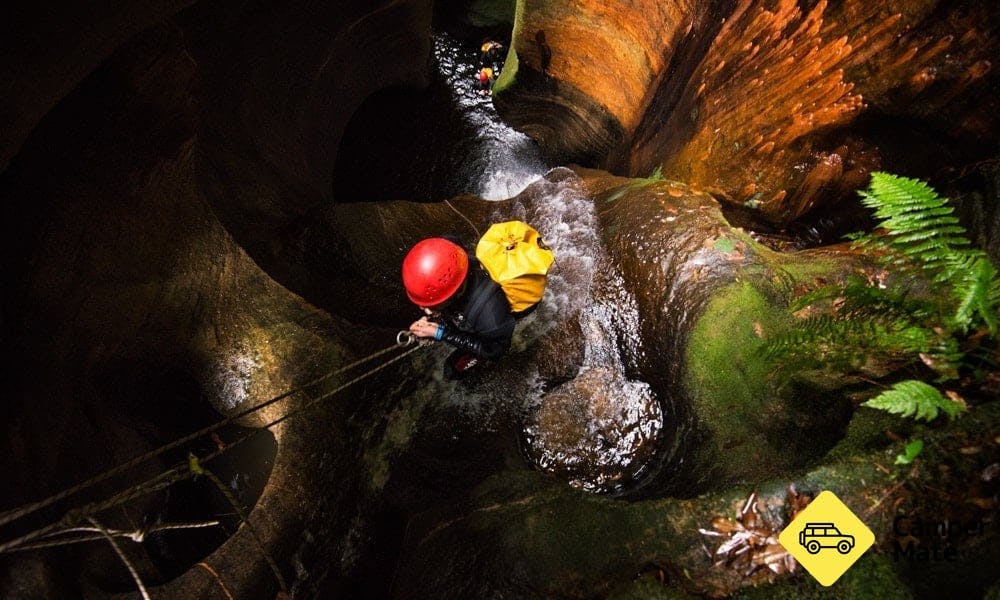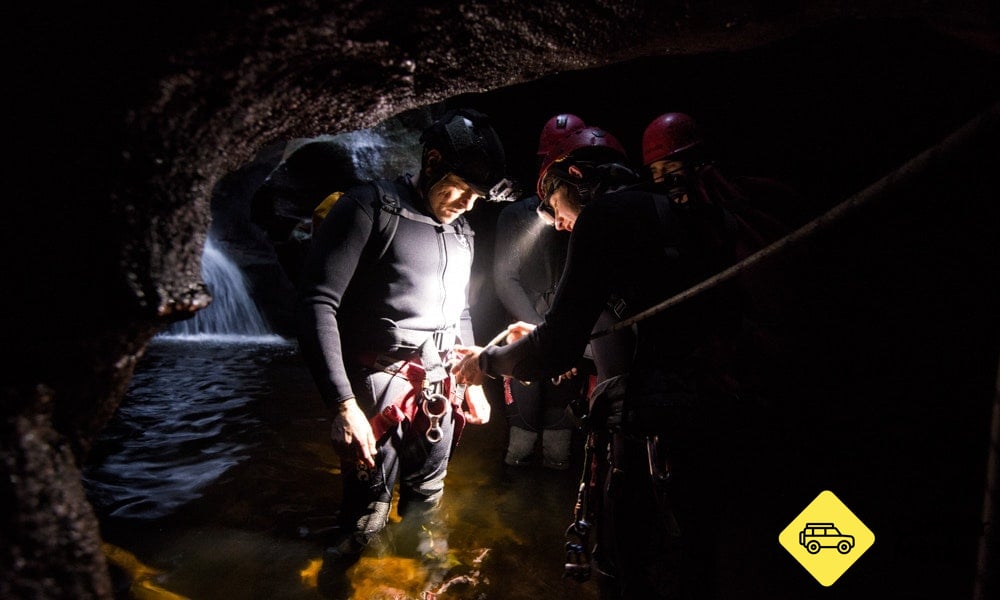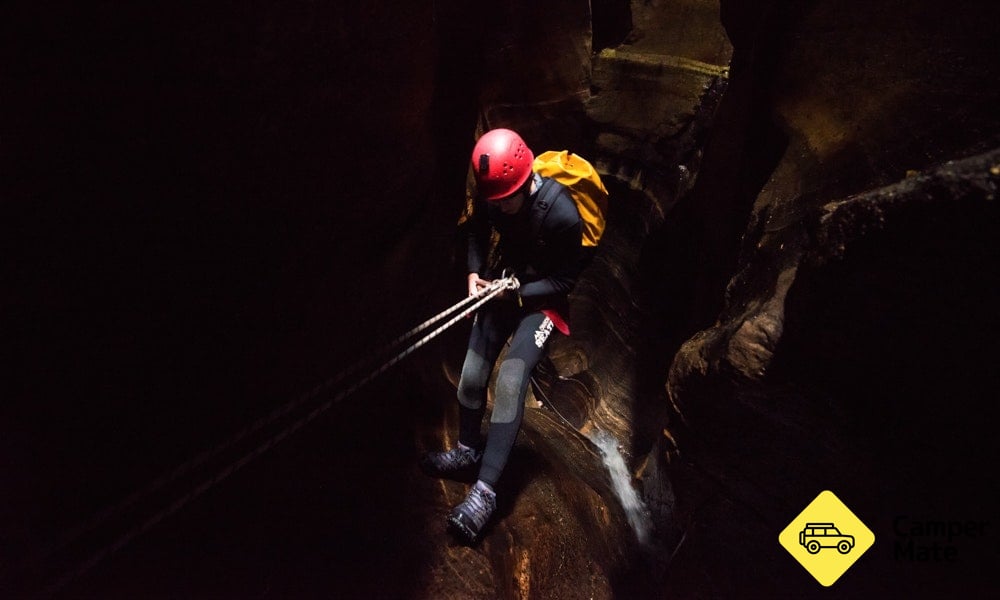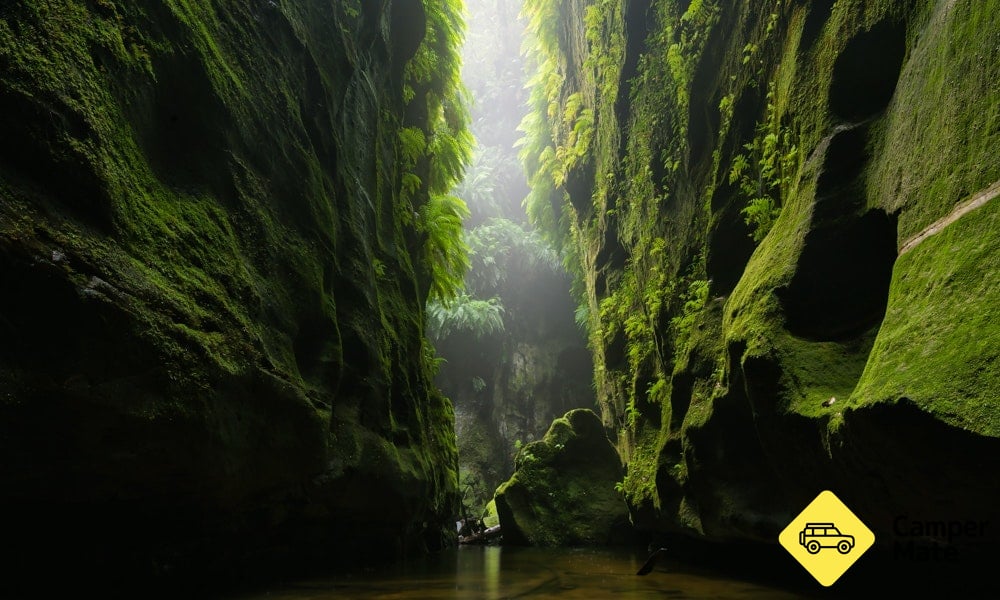
Adventure & Sports
Canyoning: have you got the skills?
February 28, 2018 • suzanne
8 min read
If you’ve ever been canyoning with a wilderness guide, we bet you’ve probably had one of the following thoughts: Why have I never done this before and Why don’t I do this more often? Often described as white water rafting without the raft, exploring million-year-old chasms is a truly unique adventure that brings gobsmacking scenery and heart-pumping thrills in equal measure.
Imagine being able to pile your mates in the car, bump your way along a fire trail, wriggle into wetsuits and spend the day jumping and sliding down a gorge, not a soul around to photo bomb your next profile pic. The good news is, independent canyoning has been going on for years, and is not impossible to do yourself.
Despite rope-based activities often being seen as dangerous, according to Blue Mountains Adventure Company guide Gill Tutton, canyoning is very safe when you have the correct, well-maintained equipment, training, and trip preparation.
“In my mind, there’s a very small risk element attached. This is because you’re able to rig (engineer) redundancy into roped activities, meaning that even if something fails, you always have a backup.”
While rope rigging is an element that can be controlled and backed up to reduce, if not eliminate, the risks, it's worth remembering that canyons are still environments that can make self-rescue or being rescued difficult.
“Imagine rolling your ankle in a slippery canyon – you can understand how a simple injury to deal with can start to become more critical in an environment where mobility is difficult, where you're experiencing potential hypothermia, and you're often quite remote without phone reception. These situations are what can make canyoning dangerous.”
“That being said, if you go with a party and ensure you have safety gear and plans, the risks are greatly diminished.”

Image credit: Jake Anderson
What You’ll Need To Know
Navigation
Bush-bashing off-trail plays a big part in canyoning, and knowing how to find your way in remote wilderness is a skill that should be prioritised above all else. Not all canyons have abseils, but nearly all canyons are wild and remote. You can apply basic bush navigation skills to canyoning: take topographic maps, track notes, a compass and PLB. Leave details of your whereabouts and expected return time safely with someone at home.
Rigging Ropes
Canyoners use ropes in a number of ways and knowing how to anchor them safely is more important than simply knowing how to abseil. (Not to strike too much fear into your hearts, but lives do depend on the rope rigger!) Even if a canyon doesn’t have any abseils, rope is sometimes needed to assist with tricky climbs and scrambles (you can’t always count on fixed ropes being there next time), not to mention emergency situations. If you don’t have these skills, do a course and practice in a low-risk environment like a climbing gym.
Abseiling
When a water jump is too high or too dangerous, canyoners rely on abseiling (also known as rappelling) to get down safely. The technique is surprisingly easy to pick up, especially if you have prior rock climbing experience.
On guided trips you’ll typically learn how to do it on the fly – overcoming the height and taking the first step is often the hardest part. You’ll need to use a belay device to control your descent, which in most cases involves sitting back into the harness and feeding the rope slowly as you “walk” down the rock wall. If you’re abseiling an overhang, taking off is a little trickier and you’ll probably go for a swing before lowering yourself in mid-air.
Rock Climbing
If you’ve ever watched Ninja Warrior, you’ll know rock climbers have a significant advantage over athletes with less dynamic backgrounds. Beyond their impressive strength and reach, climbers know how to read the rockface and contort their bodies in awkward or tight constrictions, which can be immensely beneficial in canyons. It’s useful to have this experience so you can spot less confident members of your crew.
Water Jumps
Jumping from a dizzying height into water is an amazing rush and one of the key characteristics of canyoning, but common sense should prevail. If you don’t know how deep the water is or if you haven’t checked the landing, it’s pretty simple: don’t jump. Instead, climb or abseil down to check the landing zone for depth and submerged hazards like logs and rock ledges. If all is clear step out from a standing position (run-ups can cause you to slip), keeping your arms tucked in and legs slightly bent to cushion the impact.
Water Slides
Natural water slides are found where the flow of water has eroded slippery dips in the rock. Often they’ll be short waterfalls cascading over a smooth boulder, or a chute in the rock. It’ll depend on the height and pitch of the slide, but the safest way down is sitting up, feet first with ankles together (or crossed) and arms tucked by your sides. Don’t slide face-first unless you know it’s safe to do so.
Swimming
Most wet canyons will involve swimming anywhere from a few metres to 50 metres. Even with buoyancy assistance from your backpack and wetsuit, feeling comfortable in the water is a no-brainer. The easiest way to swim in a canyon when you’re wearing a backpack is to scull on your back – and the views are better too!

Image credit: Jake Anderson
What You’ll Need To Bring
- Wetsuit or steamer (wet canyons only). The reason is twofold: it keeps you warm and cushions you from inevitable scrapes and bumps.
- Thermals. Wear one (or two if you really feel the cold) under your wetsuit.
- Helmet. It goes without saying, but canyons are slippery places and you should never venture into one without a good brain bucket. Wear a wool or fleece beanie under it.
- Rope. Because abseiling without one isn’t much fun. Static rope (non-stretch) that won’t absorb water is best. Rope can’t be hired so this is the one piece of technical equipment you’ll have to fork out for.
- Harness. A climbing harness if you already own one, or you can rent a canyoning harness. The main difference is that canyoning harnesses have a protective ‘seat’ which stops your wetsuit from getting ripped to shreds.
- Descender/belay device. This is what you’ll feed rope through to control abseil descents.
- Wool socks (to keep your feet insulated) and shoes that you don’t mind trashing. An old pair of hiking shoes with decent traction will work fine, but there are more technical shoes out there if you plan on getting serious.
- Gaiters. Optional, but could be useful if you don’t fancy getting sand in your socks.
- Map, compass, track notes and a Personal Location Beacon (PLB)
- Fleece, rain jacket and dry shoes and clothes to change into.
- Food, fuel stove, billy and emergency shelter (bothy bag).
- Backpack with a dry bag used as a liner to stuff everything into.
Final Checks
Access: Is the canyon you’re visiting open to the public? When you’re bubbling over with excitement for your imminent adventure, this one is really easy to overlook. But always check with state’s national park service for closures first. Storms, bushfires, hazards (like rock falls) and park maintenance are just some of the reasons why there might be a temporary or long term closure.
Weather: Most guided canyoning trips will still run in a drizzle – you’re going to get wet anyway. But we’d recommend saving independent trips for fair weather, and never venture out if there’s a storm forecast. In heavy rain, water levels can rise quickly, strong currents may develop, and depending where you are, dangerous flash flooding can occur.
Protecting Wild Places
If you’ve made it this far, we’d hazard a guess that you’ve already penned in a canyoning weekend (or three). You know how to navigate, rig ropes and keep you and your crew safe, and that’s awesome!
But what about keeping the canyon itself safe? Like anywhere in nature, these ancient habitats support delicate plant and animal life and Leave No Trace principles always apply. Read up on the Code of Ethics created by local canyoning communities to ensure our geological treasures remain unspoiled and open to future visitors – because you’re likely to be one of them!

Image credit: Jake Anderson
We'd like to thank Blue Mountains Adventure Company for their help with this article. Their team of guides specialise in abseiling, climbing, canyoning and hiking adventures in the Greater Blue Mountains World Heritage Area.

